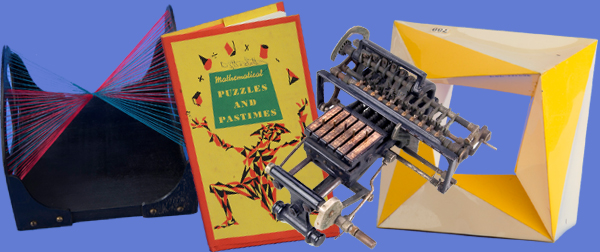
In 1915, the Mathematical Association of America formed to encourage advanced mathematics teaching in the United States. Members received a journal called The American Mathematical Monthly and participated in regular meetings. To mark the centennial of the organization, we present a few objects associated with charter members of the MAA that survive in the collections of the National Museum of American History.
Born in Virginia, Elizabeth Brown (1863-1917) moved to Washington, D.C., began teaching, and enrolled at what is now George Washington University. Simon Newcomb hired her to do calculations for the Nautical Almanac Office, and encouraged her to work permanently as a computer there. Newcomb arranged for Elizabeth Brown Davis to enroll as a special student in mathematics at Johns Hopkins University (women were not then allowed as official graduate students). When the work of her husband, Arthur Davis, took him to Los Angeles in the early 1890s. Elizabeth went along, continuing computations for Nautical Almanac and seeking private mathematics students. The family soon returned to Washington, and Davis continued her work as a computer. In March and April of 1915, Davis published solutions to problems posed in the Mathematical Monthly. Later in the year, she became a charter member of the MAA. The Monthly well suited her mathematical tastes – she published a short article in early 1917 and submitted several other problem solutions before her death that year.
Derrick N. Lehmer (1863-1938) obtained his BS from the University of Nebraska in 1893, taught in that state for a few years, and then moved on to the University of Chicago where he studied with E.H. Moore. He taught mathematics at the University of California at Berkeley from 1900 until his retirement in 1937. Lehmer took an active interest in The American Mathematical Monthly, publishing short articles in the journal from 1905 onward. When the MAA was founded, Lehmer was appointed to the Executive Council. He would be elected a vice-president of the organization and later served on the Board of Trustees. Fascinated by the properties of numbers, Lehmer published Factor table for the first ten millions containing the smallest factor of every number not divisible by 2, 3, 5, or 7 between the limits 0 and 10017000 in 1909. Assisted by the Carnegie Institution of Washington, he developed a set of paper sheets known as factor stencils to aid in factoring still large numbers.
Raymond Clare Archibald (1875-1955) once owned a German slide rule that is now in the Smithsonian collections. The object well suggests his international background. Archibald was born and raised in Nova Scotia, did further work at Harvard University, and earned his doctorate in Germany. He then returned to teach in Canada for a time, moving on to Brown University in 1908. Archibald submitted a steady stream of problems and problem solutions to the British journal Educational Times. He also began sending problems and solutions to the American Mathematical Monthly in 1910. He was appointed to the editorial board of the Monthly in 1916, served as editor-in-chief from 1919 to 1921, and was president of the MAA in 1922. In addition to his mathematical work, Archibald did much to promote the study of the history of mathematics and the improvement of mathematical tables.
Our collection database is a work in progress. We may update this record based on further research and review. Learn more about our approach to sharing our collection online.
If you would like to know how you can use content on this page, see the Smithsonian's Terms of Use. If you need to request an image for publication or other use, please visit Rights and Reproductions.